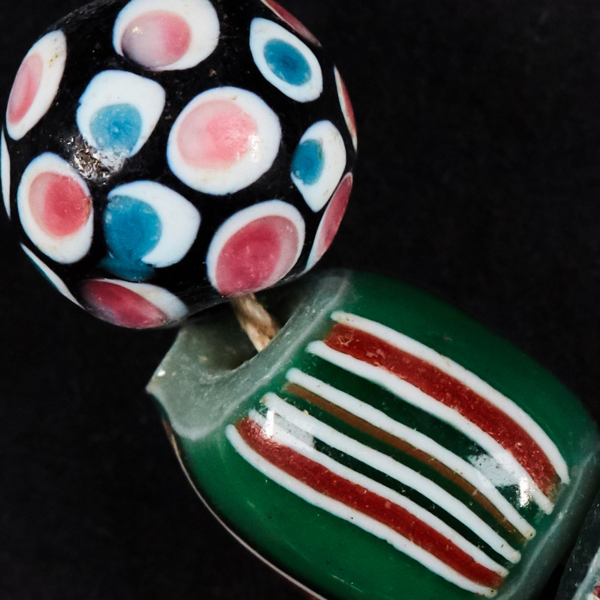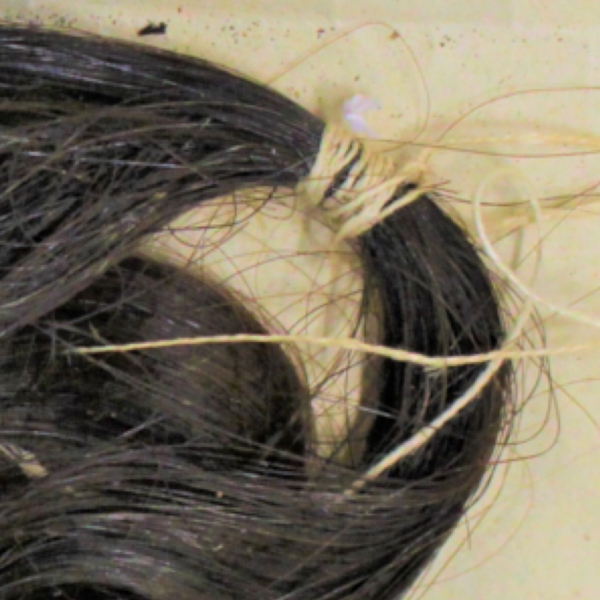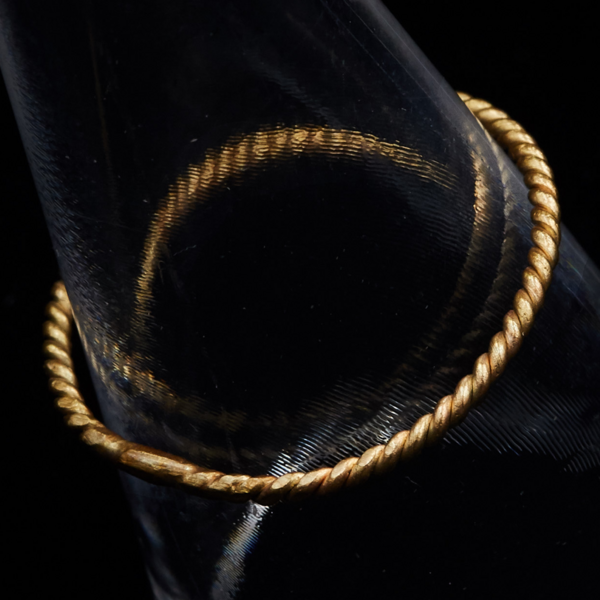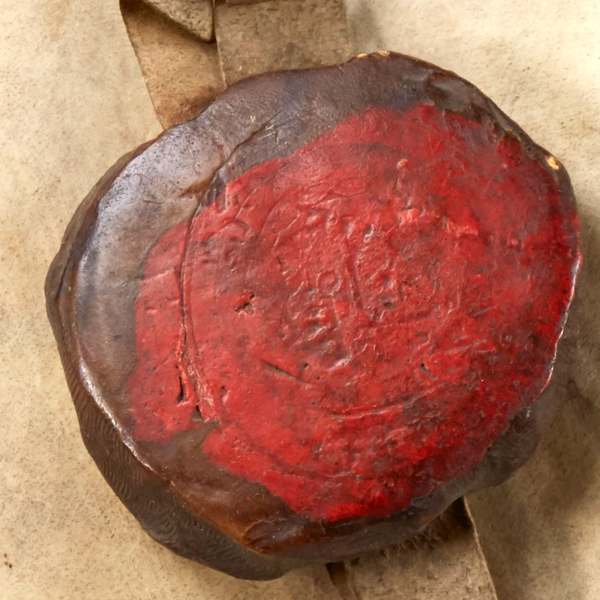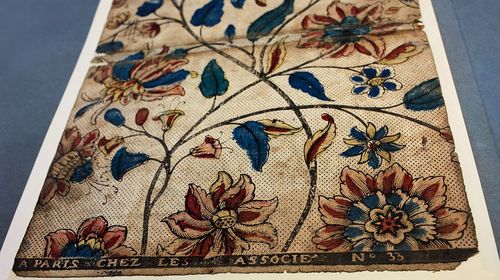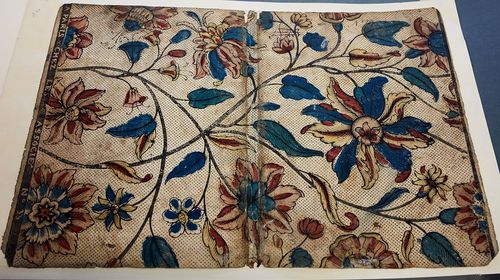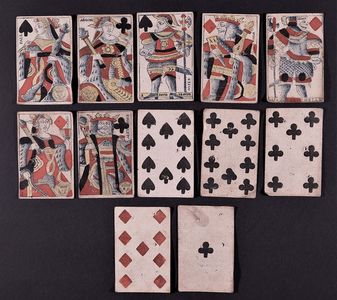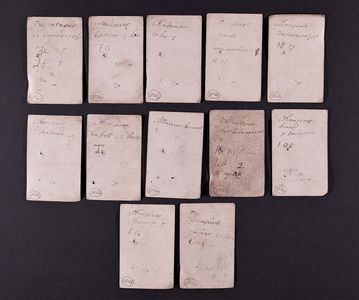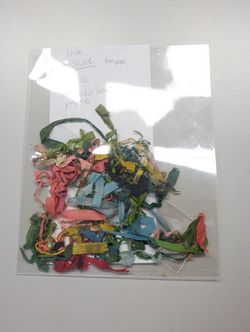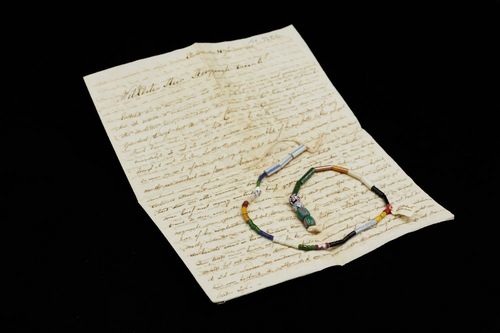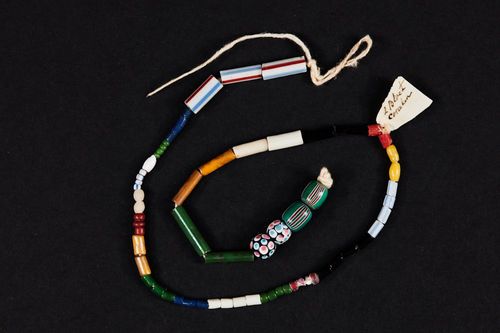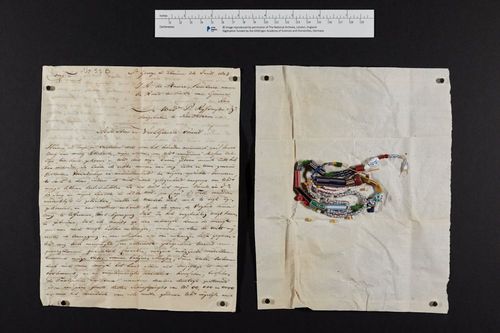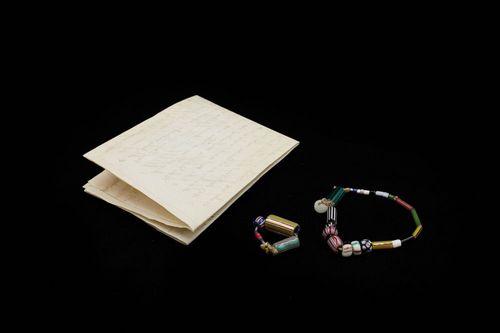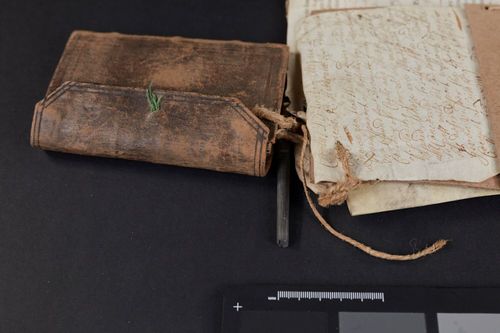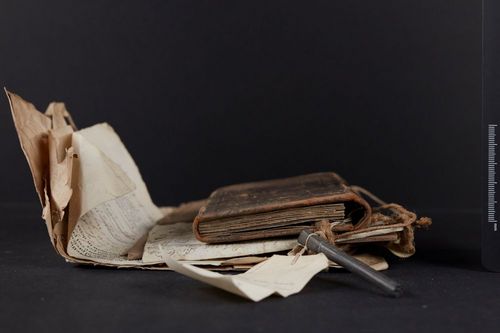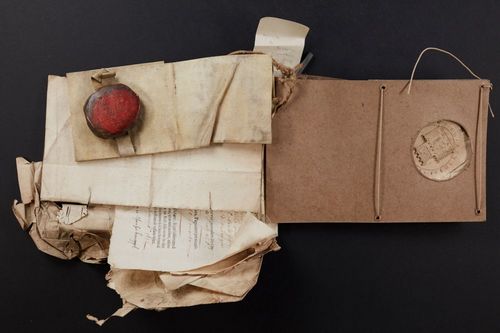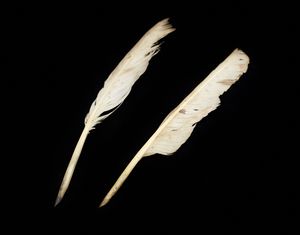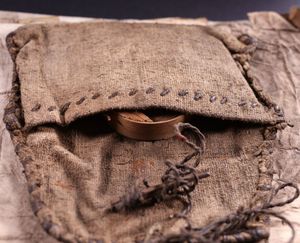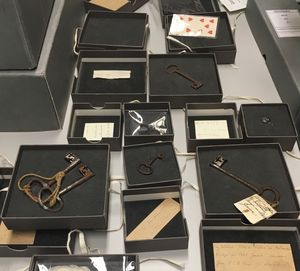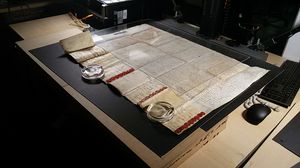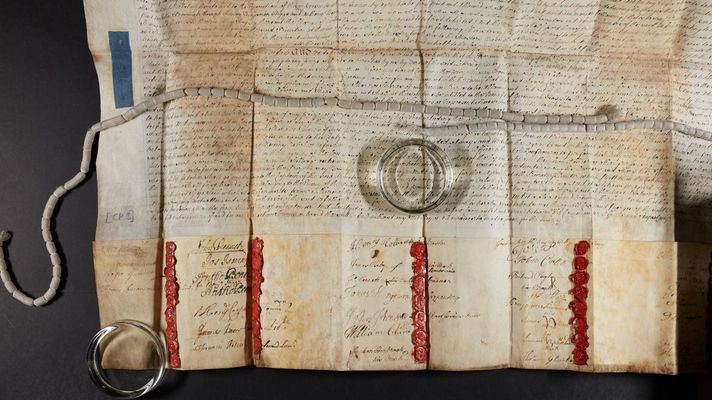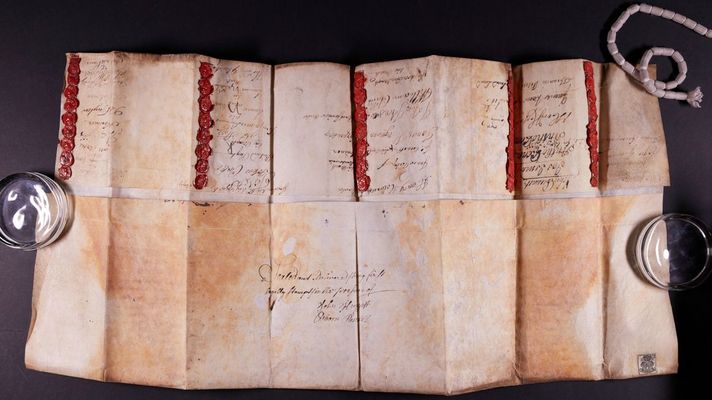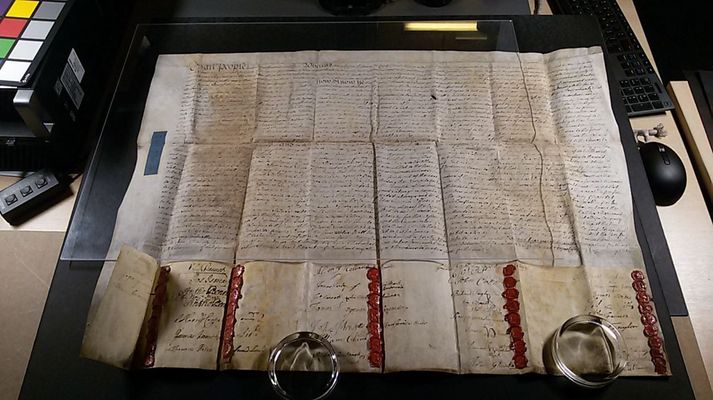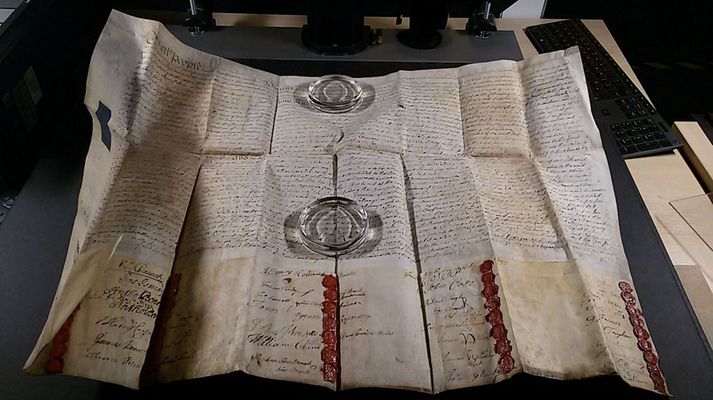Artifacts
Artifacts
Alongside thousands of documents, various other types of artifacts have survived in the Prize Papers collection; artifacts one might not expect in a collection of legal records. These artifacts were once part of the mail in transit stored on board the captured ships, they were insertions in letters, were confiscated as part of the cargo of the captured ships, or they once belonged to captains, sailors, or passengers on the ships. We digitize these artifacts individually and as part of their original material arrangements.
Wallpaper
In the picture we can see a colourful sheet of floral wallpapers with a black border and the words, 'A PARIS CHEZ LES ASSOCIE No 33', once found on a French ship captured between 1775-1783. Unfortunately, due to the fact that this artifact has been removed from its original material and archival context without documentation during the last century, we are no longer able to learn more about its history. Today, in the Prize Papers Project, the archivists and the sorting team as well as TNA’s conservators make sure and take the greatest of care to painstakingly document the original archival contexts of the artifacts. This is indispensable for the future research of these items. TNA, HCA 65/48
Find the wallpaper here.
Playing cards
Playing cards were a common item on board early modern ships. In the Prize Papers, we frequently encounter such cards or even cards sets. However, as their appearance shows, these cards apparently were not only used for gambling purposes but were also used for orders, memos, scribbling, calculations, as business cards, invoices, or other credit documents. In the example we can see a set of twelve playing cards showing different names and merchant notations written on them, symbols marking different parts of the cargo on the ships owned by different people. Since we know that these cards were found on a smuggling vessel, we can assume that they served as a kind of inofficial bill of lading for the brandy loaded on the ship. TNA, HCA 32/139/27
The cards can be found here. Learn more about Brandy smuggling here.
Ribbons
Early modern courts used tapes, strings, belts, or ribbons or other materials to bundle records and pieces of evidence together. The ribbons used show an astonishing variety of colours, the colours signifying, for instance, different kinds of evidence, different institutions like other involved courts, different court personnel. On the basis of the ribbons alone, certain court practices can be reconstructed, which shows the immense loss of information that arises if these artifacts become separated from the original documents they once kept together. The picture shows a transparent cover enclosing loose ribbons once separated from their material bundles in the past. Today, were possible, Collection Care tries to preserve the ribbons, while at the same time new ribbons, longer belts, or alternative bundling material, and of course blue archive folders are added to the collection of artifacts stored in the Prize Papers collection.
Glass beads
During the early modern period, glass beads were not only used as jewellery, but also as a currency. Gaining sad notoriety, these trade beads played a particularly crucial role in the West African slave trade as a payment method. Today, when we admire the beauty, the colourfulness, the joyful designs of these precious artifacts, we should be aware that during the seventeenth and eighteenth centuries, millions of such beads were shipped in barrels from Europe to Africa as part and in support of the triangular slave trade. The bead necklaces in the picture were found in 2017 by our Dutch colleagues in letters coming from Elmina castle, the headquarters of the Dutch slave forts in West Africa, addressed to relatives and famous merchant houses in the beads trade in Amsterdam, a centre of bead making. These beads were to serve as samples for the merchants of future shipments. The artifacts have survived in astonishing condition. Sheltered for centuries in closed letters, they look good as new, which, given the historical background of these beads, leaves the viewers both amazed and deeply moved. After the materiality shots and digital images of these artifacts and the corresponding letters were produced by our imaging operators, they have now been transferred to the TNA safe rooms.
TNA, HCA 32/996
· Learn more about the ship on which the letters were found here. Learn more about Materiality Shots here.
· Learn more about these artifacts in Erik van der Doe’s article “Small hidden treasures in the Prize Papers: Beads and gold rings from West Africa”, Magazine of the Friends of The National Archives, November 2019, Vol. 30, No. 2.
Pencils and seals
Due to the circumstances of capture, it is also not uncommon that even original pencils have survived, tied to books or inserted in them. In some instances, even letters have been inserted into the books. Here we can see a small notebook with a pencil found on board the ship Azië. As part of this court bundle, many official seals also survived. TNA, HCA 30/652
For more information follow the link.
Quill pens
These quill pens were found between the pages of a bound volume that once belonged to the ship's captain Teunis Kersies Klyn, the captain of the Dutch ship "Jonge Johannes", which was captured by the privateer Eagle in 1746. The book contains information about past voyages and some financial reports. The quills were found wrapped in a loose piece of blank paper for safe keeping and perhaps to avoid stains on the journal's pages. They still have ink on them, so potentially it was the captain himself who last used them.
Learn more about the ship here.
Sailcloth pouch
Surely one of the most intriguing items of the Prize Papers collection are the confiscated personal belongings of sailors serving on captured ships. Here the picture shows a small sailcloth pouch with a round wooden box and a wooden pin which once belonged to a sailor on board the Flemish herring buss, ‘Haringbuis’, Sint Andries. The ship, returning from fishing for herring in the North Sea, came into the English fleet off Walcheren on 30 July 1666, and was sent into the River Thames. TNA, HCA 30/641/1
Learn more about this ship here.
Keys
Keys are a common find in the Prize Papers collection. Only speaking of the War of the Austrian Succession, several dozens of keys, in all shapes and sizes, have survived. These keys were either sent in letter packages, were found among the cargo by the privateer crew, e.g., still left in the lock of original chests, or found among the personal belongings of the crew or passengers. The keys are now stored in TNA, HCA 65
Parchment
This is a large parchment which has a series of wax seals on the bottom part. The parchment tends to fold back. In order to keep it flat, the imaging operator needs to use plexiglass, but this can be applied only in some portions of the parchment and not on wax seals for preservation reasons. Therefore the final image has been taken in several shots, some with plexiglass, and some without, to be stitched together in Photoshop.


